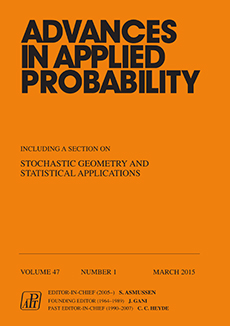Abstract
The 'coupon collection problem' refers to a class of occupancy problems in which j identical items are distributed, independently and at random, to n cells, with no restrictions on multiple occupancy. Identifying the cells as coupons, a coupon is 'collected' if the cell is occupied by one or more of the distributed items; thus, some coupons may never be collected, whereas others may be collected once or twice or more. We call the number of coupons collected exactly r times coupons of type r. The coupon collection model we consider is general, in that a random number of purchases occurs at each stage of collecting a large number of coupons; the sample sizes at each stage are independent and identically distributed according to a sampling distribution. The joint behavior of the various types is an intricate problem. In fact, there is a variety of joint central limit theorems (and other limit laws) that arise according to the interrelation between the mean, variance, and range of the sampling distribution, and of course the phase (how far we are in the collection processes). According to an appropriate combination of the mean of the sampling distribution and the number of available coupons, the phase is sublinear, linear, or superlinear. In the sublinear phase, the normalization that produces a Gaussian limit law for uncollected coupons can be used to obtain a multivariate central limit law for at most two other types - depending on the rates of growth of the mean and variance of the sampling distribution, we may have a joint central limit theorem between types 0 and 1, or between types 0, 1, and 2. In the linear phase we have a multivariate central limit theorem among the types 0, 1,..., k for any fixed k.
Citation
Hosam M. Mahmoud. Robert T. Smythe. "On the joint behavior of types of coupons in generalized coupon collection." Adv. in Appl. Probab. 44 (2) 429 - 451, June 2012. https://doi.org/10.1239/aap/1339878719
Information





